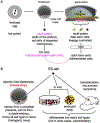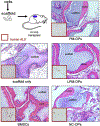Induced pluripotent stem cell technology in bone biology
- PMID: 37028583
- PMCID: PMC10228209
- DOI: 10.1016/j.bone.2023.116760
Induced pluripotent stem cell technology in bone biology
Abstract
Technologies on the development and differentiation of human induced pluripotent stem cells (hiPSCs) are rapidly improving, and have been applied to create cell types relevant to the bone field. Differentiation protocols to form bona fide bone-forming cells from iPSCs are available, and can be used to probe details of differentiation and function in depth. When applied to iPSCs bearing disease-causing mutations, the pathogenetic mechanisms of diseases of the skeleton can be elucidated, along with the development of novel therapeutics. These cells can also be used for development of cell therapies for cell and tissue replacement.
Keywords: Induced pluripotent stem cells R; Models of disease; Osteogenic differentiation; Pluripotent stem cells; Reprogramming.
Published by Elsevier Inc.
Conflict of interest statement
Conflict of interest The authors have no conflicts of interest pertaining to the subject matter of this review.
Figures






Similar articles
-
Preferential Hematopoietic Differentiation in Induced Pluripotent Stem Cells Derived From Human Umbilical Cord Arterial Endothelial Cells.Arterioscler Thromb Vasc Biol. 2023 May;43(5):697-712. doi: 10.1161/ATVBAHA.122.318723. Epub 2023 Mar 23. Arterioscler Thromb Vasc Biol. 2023. PMID: 36951064
-
Robust Differentiation of mRNA-Reprogrammed Human Induced Pluripotent Stem Cells Toward a Retinal Lineage.Stem Cells Transl Med. 2016 Apr;5(4):417-26. doi: 10.5966/sctm.2015-0093. Epub 2016 Mar 1. Stem Cells Transl Med. 2016. PMID: 26933039 Free PMC article.
-
A novel model of urinary tract differentiation, tissue regeneration, and disease: reprogramming human prostate and bladder cells into induced pluripotent stem cells.Eur Urol. 2013 Nov;64(5):753-61. doi: 10.1016/j.eururo.2013.03.054. Epub 2013 Apr 6. Eur Urol. 2013. PMID: 23582880 Free PMC article.
-
Hematopoietic stem cells from induced pluripotent stem cells - considering the role of microRNA as a cell differentiation regulator.J Cell Sci. 2018 Feb 21;131(4):jcs203018. doi: 10.1242/jcs.203018. J Cell Sci. 2018. PMID: 29467236 Review.
-
Concise Review; The Recent Methods that Enhance the Osteogenic Differentiation of Human Induced Pluripotent Stem Cells.Curr Stem Cell Res Ther. 2021;16(8):949-957. doi: 10.2174/1574888X16666210203112016. Curr Stem Cell Res Ther. 2021. PMID: 33563178 Review.
Cited by
-
Identifying the best reference gene for RT-qPCR analyses of the three-dimensional osteogenic differentiation of human induced pluripotent stem cells.Bone Rep. 2024 Nov 17;23:101816. doi: 10.1016/j.bonr.2024.101816. eCollection 2024 Dec. Bone Rep. 2024. PMID: 39664802 Free PMC article.
-
A NOTCH2 pathogenic variant and HES1 regulate osteoclastogenesis in induced pluripotent stem cells.Bone. 2025 Feb;191:117334. doi: 10.1016/j.bone.2024.117334. Epub 2024 Nov 19. Bone. 2025. PMID: 39571704
-
Animal models for musculoskeletal research.Bone. 2023 Aug;173:116813. doi: 10.1016/j.bone.2023.116813. Epub 2023 May 25. Bone. 2023. PMID: 37244428 Free PMC article. No abstract available.
References
-
- Hooke R, Micrographia: or some physiological descriptions of minute bodies made by magnifying glasses with observations and inquiries thereupon, Allestry J and Martyn J, London, 1665.
-
- Folkes M, Some account of Mr Leeuwenhoek’s curious microsopes lately presented to the Royal Society, Philosophical Transactions 32(380) (1723) 446–453.
-
- Schwann T, Schleiden MJ, Beiträge zur Phytogenesis, in: Muller J (Ed.), Archiv für Anatomie, Physiologie und wissenschaftliche Medicin, Eichler G, Berlin, 1838, pp. 137–176.
-
- Virchow R, Die Cellularpathologie in ihrer Begründung und in ihrer Auswirkung auf die physiologische und pathologische Gewebelehre, Hirschwald Verlag A., Berlin, 1858.
-
- Remak R, Untersuchungen uber die Entwickelung der Wirbelthiere, Reimer G, Berlin, 1855.
Publication types
MeSH terms
Grants and funding
LinkOut - more resources
Full Text Sources

